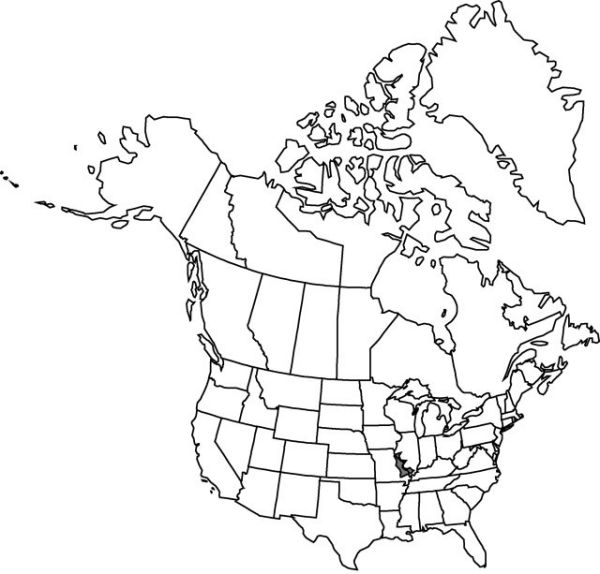Difference between revisions of "Trillium viride"
Amer. J. Sci. Arts 11: 178. 1826.
FNA>Volume Importer |
imported>Volume Importer |
||
| (6 intermediate revisions by 2 users not shown) | |||
| Line 8: | Line 8: | ||
}} | }} | ||
|common_names=Green trillium | |common_names=Green trillium | ||
| + | |special_status={{Treatment/ID/Special_status | ||
| + | |code=E | ||
| + | |label=Endemic | ||
| + | }} | ||
|basionyms= | |basionyms= | ||
|synonyms= | |synonyms= | ||
| Line 24: | Line 28: | ||
|elevation=100–200 m | |elevation=100–200 m | ||
|distribution=Ill.;Mo. | |distribution=Ill.;Mo. | ||
| − | |discussion=<p>Trillium viride has long been confused with T. luteum of the Smoky Mountain region, though it is far more slender and delicate than T. luteum. Because the pallid forms and so-called albinos of many other sessile trilliums described in written accounts sound much like the description of this plant, early authors ascribed far too wide a range to T. viride. The plant is closely limited to the woodlands of the counties adjacent to the Missouri River in northeastern Missouri and southern Illinois.</p><!-- | + | |discussion=<p><i>Trillium viride</i> has long been confused with <i>T. luteum</i> of the Smoky Mountain region, though it is far more slender and delicate than <i>T. luteum</i>. Because the pallid forms and so-called albinos of many other sessile trilliums described in written accounts sound much like the description of this plant, early authors ascribed far too wide a range to <i>T. viride</i>. The plant is closely limited to the woodlands of the counties adjacent to the Missouri River in northeastern Missouri and southern Illinois.</p><!-- |
| − | --><p>Although the ranges of Trillium viride and the very similar T. viridescens do not overlap, both species grow in Missouri, and authors earlier than J. D. Freeman (1975) frequently combined the two as a single species. If all other means of identification fail, the prevalence of numerous stomates on the adaxial bract surface, seen under magnification, will always distinguish T. viride.</p> | + | --><p>Although the ranges of <i>Trillium viride</i> and the very similar <i>T. viridescens</i> do not overlap, both species grow in Missouri, and authors earlier than J. D. Freeman (1975) frequently combined the two as a single species. If all other means of identification fail, the prevalence of numerous stomates on the adaxial bract surface, seen under magnification, will always distinguish <i>T. viride</i>.</p> |
|tables= | |tables= | ||
|references= | |references= | ||
| Line 34: | Line 38: | ||
-->{{#Taxon: | -->{{#Taxon: | ||
name=Trillium viride | name=Trillium viride | ||
| − | |||
|authority=L. C. Beck | |authority=L. C. Beck | ||
|rank=species | |rank=species | ||
| Line 48: | Line 51: | ||
|publication title=Amer. J. Sci. Arts | |publication title=Amer. J. Sci. Arts | ||
|publication year=1826 | |publication year=1826 | ||
| − | |special status= | + | |special status=Endemic |
| − | |source xml=https:// | + | |source xml=https://bitbucket.org/aafc-mbb/fna-data-curation/src/2e0870ddd59836b60bcf96646a41e87ea5a5943a/coarse_grained_fna_xml/V26/V26_142.xml |
|genus=Trillium | |genus=Trillium | ||
|subgenus=Trillium subg. Phyllantherum | |subgenus=Trillium subg. Phyllantherum | ||
Latest revision as of 21:13, 5 November 2020
Rhizomes horizontal, brownish, short, slender to stout, praemorse, not brittle. Scapes 1–3, round in cross section, 2.3–3.4+ dm, ± slender, smooth to scabrous below bracts. Bracts held well above ground, sessile; blade green to bluish green, weakly mottled, rarely unmottled, mottling becoming obscure with age, adaxial surface covered with numerous stomata easily visible under a lens, occasionally visible as tiny white dots to the naked eye, narrowly to broadly elliptic, 8–20.5 × 5–8 cm, not glossy, apex blunt to rounded-acute. Flower erect, odor of decayed fruit; sepals displayed above bracts, widely spreading, distal 1/2 often weakly declined, green, lanceolate-acute, 28–60 × 7–9 mm, margins entire, apex acute; petals long-lasting, erect to widely spreading, ± connivent, ± concealing stamens and ovary, green, yellowish green, yellow, or variously purple streaked throughout, especially basally (rarely all purplish green), not spirally twisted, narrowly spatulate to linear-spatulate, 3.5–6.8 × 0.5–1.5 cm, widest above middle, thick-textured, base narrowed and thickened, ± forming claw, margins entire, apex obtuse, lacking nipple; stamens relatively straight-erect to slightly incurved, 15–25 mm; filaments brown-olive, 3–5.5 mm, dilated basally; anthers erect, straight, olive-brown or purplish, 8–21 mm, ± slender, dehiscence introrse-latrorse; connectives olive, straight, very slightly (± 0.5 mm) extended beyond sacs; ovary greenish basally, olive-purplish distally, ellipsoid to ovoid, deeply angled, 5–12 mm; stigmas spreading-erect, recurved, distinct, sessile, olive or purplish, subulate, 5–10 mm, somewhat fleshy. Fruits greenish white, odorless, ovoid, angled, 1–1.5 cm, somewhat pulpy, not juicy. 2n = 10.
Phenology: Flowering spring (late Apr–May).
Habitat: Rich woods, bluffs, rocky hillsides with some limestone outcrops, woodsy, humusy soil over fairly stiff, clayey substrate
Elevation: 100–200 m
Discussion
Trillium viride has long been confused with T. luteum of the Smoky Mountain region, though it is far more slender and delicate than T. luteum. Because the pallid forms and so-called albinos of many other sessile trilliums described in written accounts sound much like the description of this plant, early authors ascribed far too wide a range to T. viride. The plant is closely limited to the woodlands of the counties adjacent to the Missouri River in northeastern Missouri and southern Illinois.
Although the ranges of Trillium viride and the very similar T. viridescens do not overlap, both species grow in Missouri, and authors earlier than J. D. Freeman (1975) frequently combined the two as a single species. If all other means of identification fail, the prevalence of numerous stomates on the adaxial bract surface, seen under magnification, will always distinguish T. viride.
Selected References
None.
